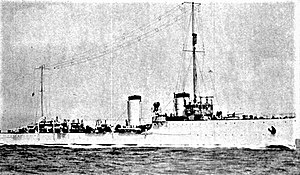
| |
| Class overview | |
|---|---|
| Builders | Ansaldo, Genoa |
| Operators | |
| Preceded by | Aquila class |
| Succeeded by | La Masa class |
| Built | 1914–1917 |
| In commission | 1917–1945 |
| Planned | 3 |
| Completed | 3 |
| Lost | 2 |
| Scrapped | 1 |
| General characteristics (Carlo Mirabello as built) | |
| Type | Destroyer |
| Displacement | |
| Length | 103.75 m (340 ft 5 in) |
| Beam | 9.74 m (31 ft 11 in) |
| Draught | 3.3 m (10 ft 10 in) |
| Installed power |
|
| Propulsion | 2 shafts; 2 geared steam turbines |
| Speed | 35 knots (65 km/h; 40 mph) |
| Range | 2,300 nmi (4,300 km; 2,600 mi) at 12 knots (22 km/h; 14 mph) |
| Complement | 8 officers and 161 enlisted men |
| Armament |
|
The Mirabello-class were a group of three destroyers (originally scout cruisers) built for the Regia Marina (Royal Italian Navy) during World War I. Carlo Alberto Racchia was sunk by a mine in the Black Sea during the Allied intervention in the Russian Civil War in 1920. The remaining two ships, obsolescent by 1938, were re-rated as destroyers and participated in World War II. Carlo Mirabello was also lost to a mine while escorting a convoy in 1941. The last surviving ship, Augusto Riboty, was reconfigured as a convoy escort in 1942–1943. The torpedo tubes were removed and depth charges and 20 mm (0.79 in) anti-aircraft guns added. She survived the war and was supposed to be transferred to the Soviet Union as war reparations in 1946, but she was obsolescent so money was accepted instead, and she remained in the italian navy until the early 1950s. The ship was scrapped five years later.